North America is home to various blue and black wasps. Some of these wasps are common around homes, especially when there’s food for their larvae such as crickets. Most blue and black wasps are solitary and live further out on open land.
Meadows, prairies, woodlands, and even desserts are known homes for some of the most common blue and black wasps in North America.
While many feed on plant nectar, blue and black wasps can also be carnivorous. They feed live or dead roaches or insects to their larvae which are dependent on food for growth.
Some blue and black wasps are also parasitic. They can lay eggs in the nests of other species. These wasps are often known for laying eggs directly in a host such as a cockroach or a grub where larvae emerge directly into a food source.
Table of Contents
Are Blue Wasps Dangerous?
Blue wasps are some of the most dangerous types of wasps in the US. These wasps aren’t particularly known for chasing people, but they can sting whenever threatened or roughly handled.
The sting of these wasps can have minor effects such as short-lived pain. On the other hand, the sting can also lead to necrosis and come with high levels of pain which don’t quickly subside.
Many blue and black wasps have a venomous bite. The venom can paralyze small insects and cause allergic reactions in humans.
15 Blue and Black-Blue Wasps
The following species of blue and black-blue wasps are the most common in North America. Most are also native to the US.
1. Nearctic Blue Mud-dauber Wasp
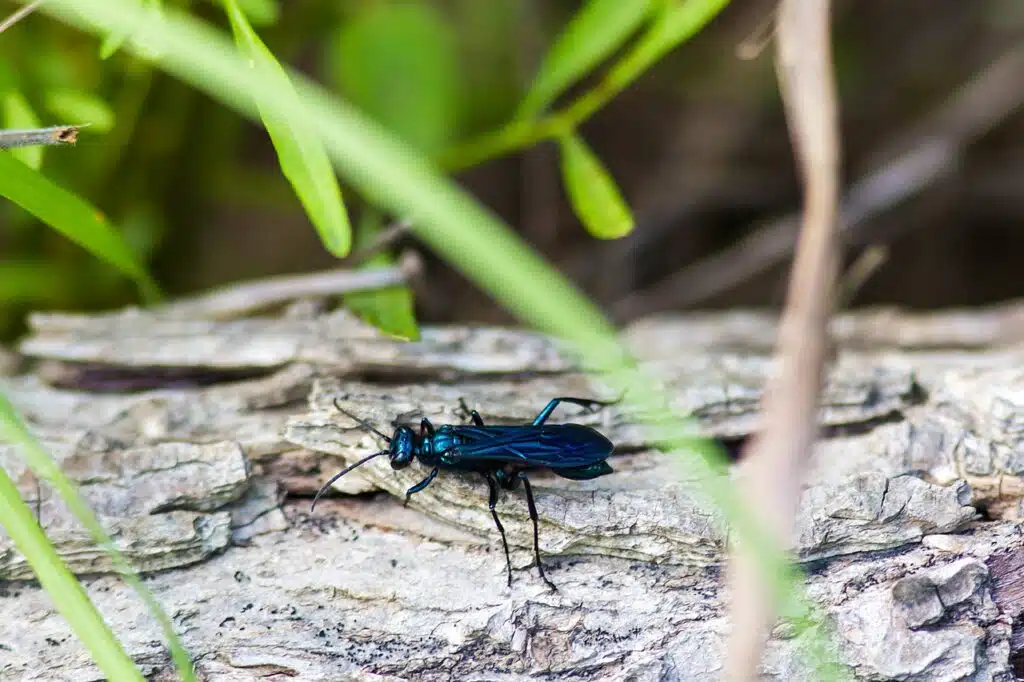
The Nearctic Blue Mud-dauber wasp (Chalybion californicum) has a dark-color body. It has dark blue coloring with black wings.
Wasps of this species are further known for having a metallic color which makes them appear glossy in direct sunlight. with black wings.
Wasps of this species are further known for having a metallic color which makes them appear glossy in direct sunlight.
As its name implies, this is a species that builds mud nests.
The female Nearctic Blue Mud-dauber wasp is mainly responsible for building mud nests.
Most females prefer to repurpose old nests as there’s not as much work to put in.
Females prefer to repair and repurpose old Nearctic Blue Mud-dauber nests.
2. Blue-winged Scoliid Wasp
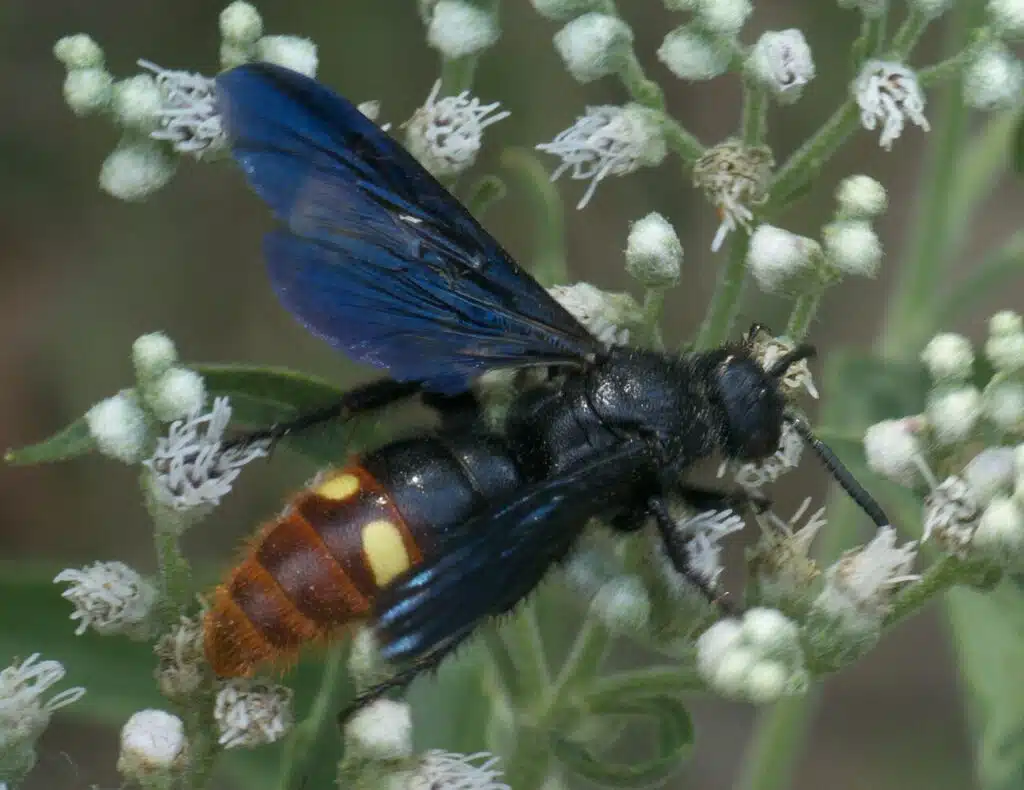
The Blue-winged Scoliid wasp (Scolia dubia) gets its name from its coloring, just as most wasps of this family.
Wasps of this species have blue-black or dark blue wings. The wings are long with visible veins.
Blue-winged Scoliid wasps have a blue and orange striped body.
You can see Blue-winged Scoliid wasps late in the summer.
Some members of this species continue collecting nectar early in the early fall.
This species is also known for being a grub parasite. Female wasps lay eggs that grow inside grubs.
3. Blue-eyed Ensign Wasp
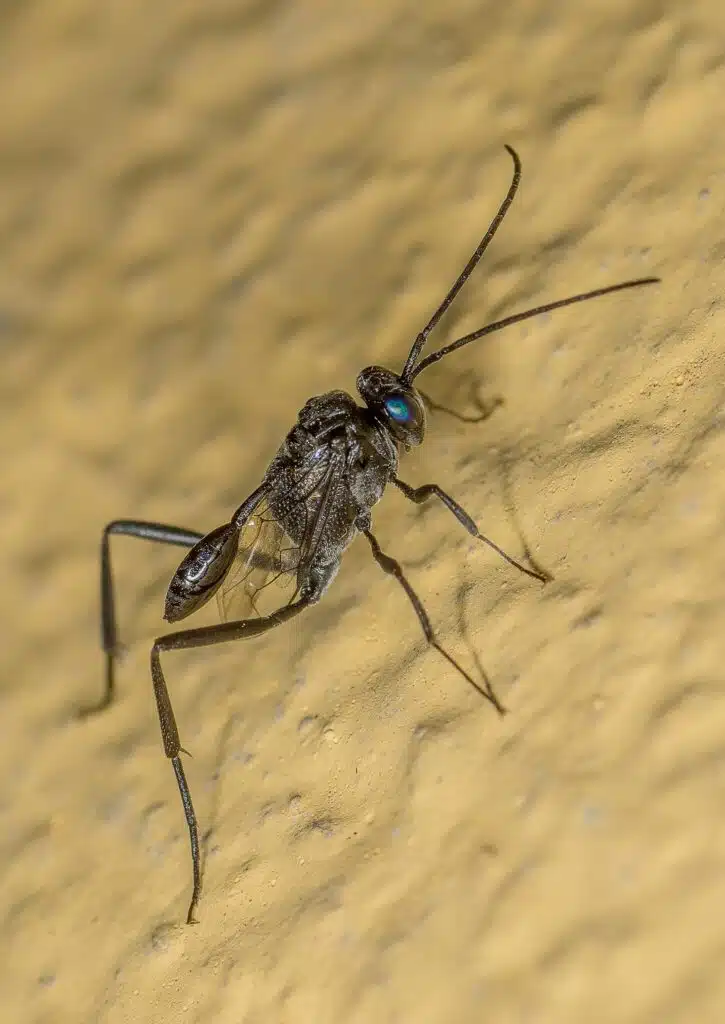
Blue-eyed Ensign wasps (Evania appendigaster) have a black and blue body.
Wasps of the species have large blue eyes which contrast the black shiny body of the species.
Apart from the contrasting coloring, the Blue-eyed Ensign wasp is also known as a cockroach parasite.
The wasp lays its eggs directly in the eggs of cockroaches. Host species include the American cockroach and the Harlequin cockroach among others.
Female wasps lay eggs in the eggs of cockroaches which then hatch having plenty of food to consume.
The small wasp species is known for growing mandibles fast. The larvae of the species are known for eating cockroach eggs with 3 eggs.
You can typically find these wasps in the garden. They live close to roaches and are often seen feeding on parsley.
4. Steel-blue Cricket-hunter Wasp
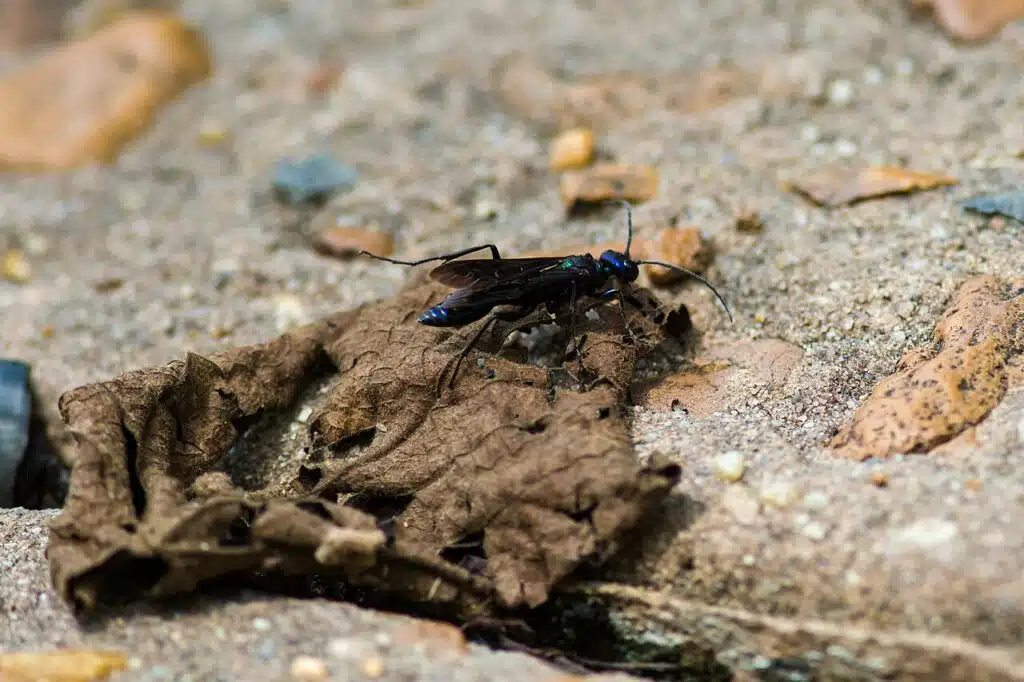
The Steel-blue Cricket-hunter wasp (Chlorion aerarium) is a common species around homes even if it mostly lives in open areas.
You can identify this species by its dark blue body and green marks. It also has blue-black wings, black antennae, and black legs.
Crickets are the main food source for the larvae of the Steel-blue Cricket-hunter wasp.
The female catches crickets and then proceeds to drag them to the nest.
Female wasps always drag the cricket on the ground to avoid other females stealing the cricket in the air.
Multiple crickets are taken back to the nest where as many as 9 nymphs could be waiting for food.
This species is commonly seen around homes in gardens with plenty of crickets even if the female wasps prefer to lay eggs further away from people.
5. Metallic Bluish-green Cuckoo Wasp
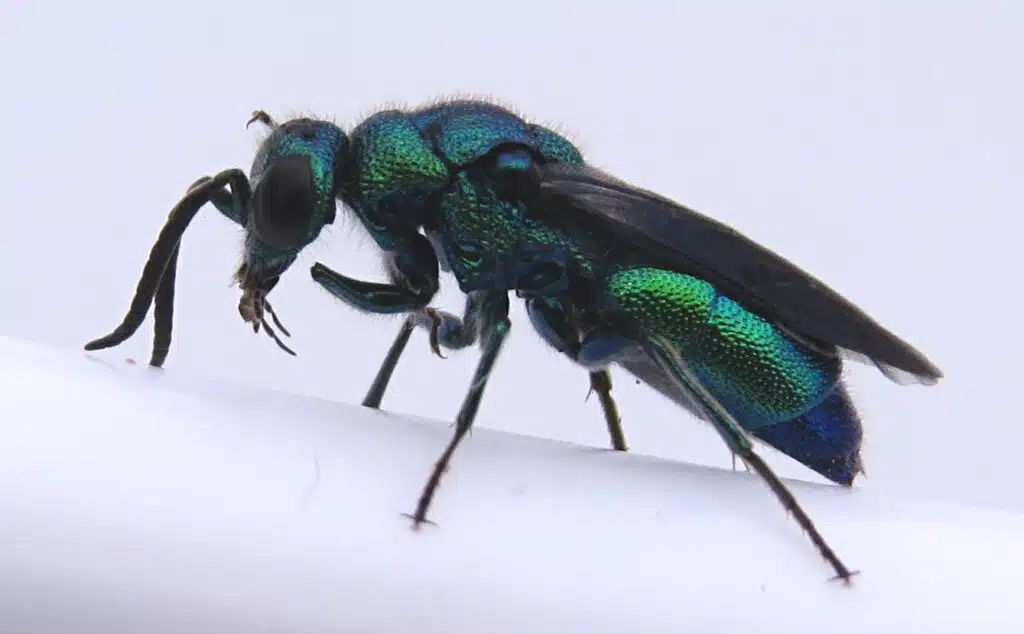
The Metallic Bluish-green Cuckoo wasp (Chrysis angolensis) is an imported species that are now established in North America.
It made its way to the US after the Second World War and established itself in various deserts.
The species has a blue-green body with a metallic nuance.
It’s known for being a parasitic species with little effect on its hosts as it lives solitary lives.
Female Metallic Bluish-green Cuckoo wasps lay their eggs in the nests of other species, particularly in the nest of bees. They also kill all eggs and larvae found in these nests.
6. Emerald Cockroach Wasp
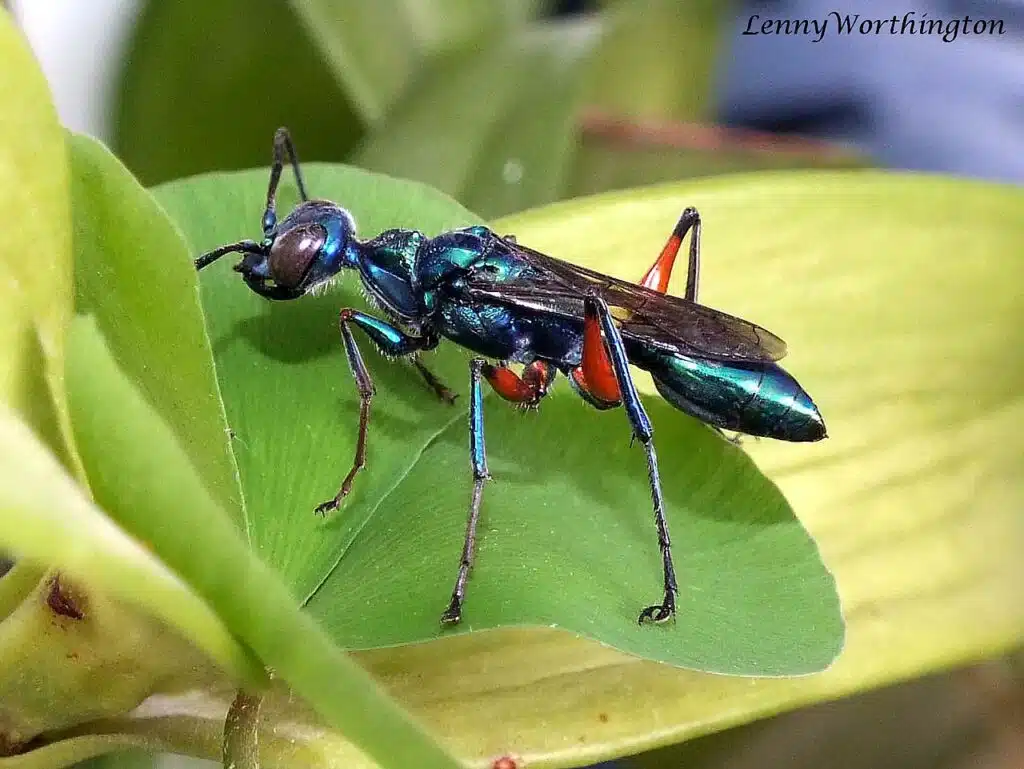
The Emerald Cockroach wasps (Ampulex compressa) is a specialized species with a blue-green body and red spots.
Like another metallic color wasp, the Emerald Cockroach wasp has slightly different nuances in changing light.
This species is one of the most considerable cockroach parasites. It feeds cockroaches to its young for food.
Emerald Cockroach wasps sting cockroaches twice to get full control over them.
These wasps have unique venom which doesn’t paralyze roaches completely. It allows the wasps to control the species but without fully paralyzing them which means transporting to the nest is easier.
7. Pepsis grossa
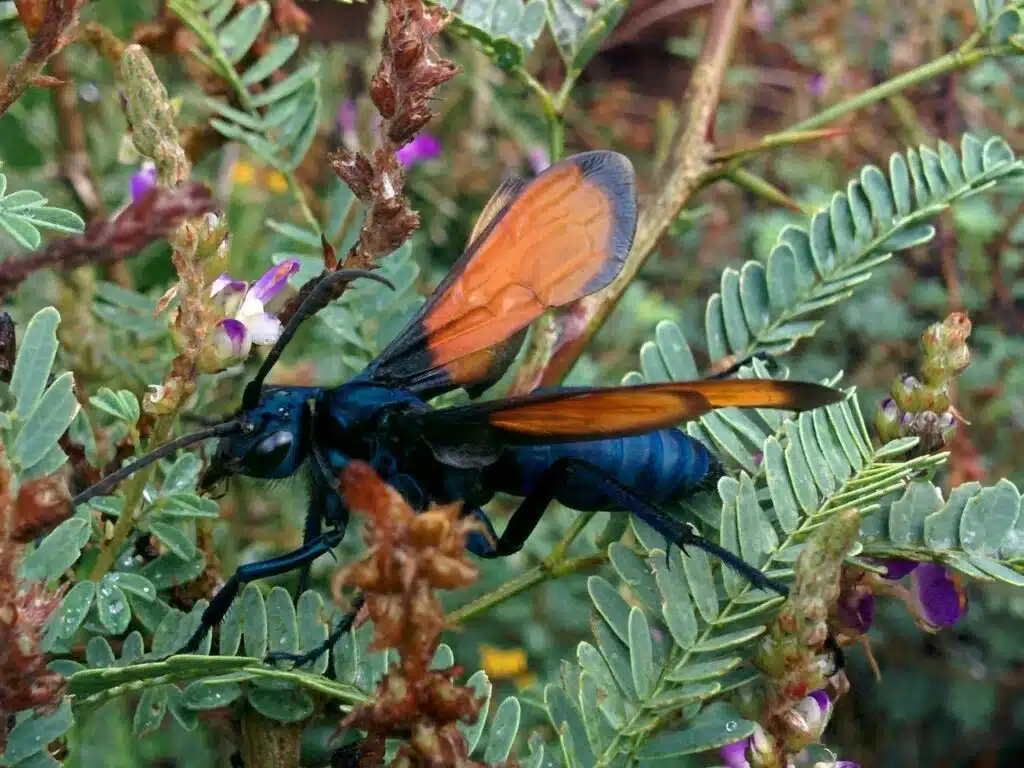
Pepsis grossa is one of the most popular types of black and blue wasps. The popularity of the species mainly comes from the painful sting this wasp can deliver.
Pepsis gross stings are among the most painful in the world.
You can identify this species by its dark blue body with black wings and orange wings. The combination of blue, black, and orange are common for the species (as well as for other similar wasps in Mexico).
Apart from the deadly sting, this species is also common for its capacity to produce a bad odor.
This bad odor is the first warning that the species is dangerous and one of the first reasons there aren’t too many Pepsis grossa predators.
Females of the species are some of the largest black and blue wasps in the US. They grow to a size of over 50mm.
8. Zimmerman’s Mud-dauber Wasp
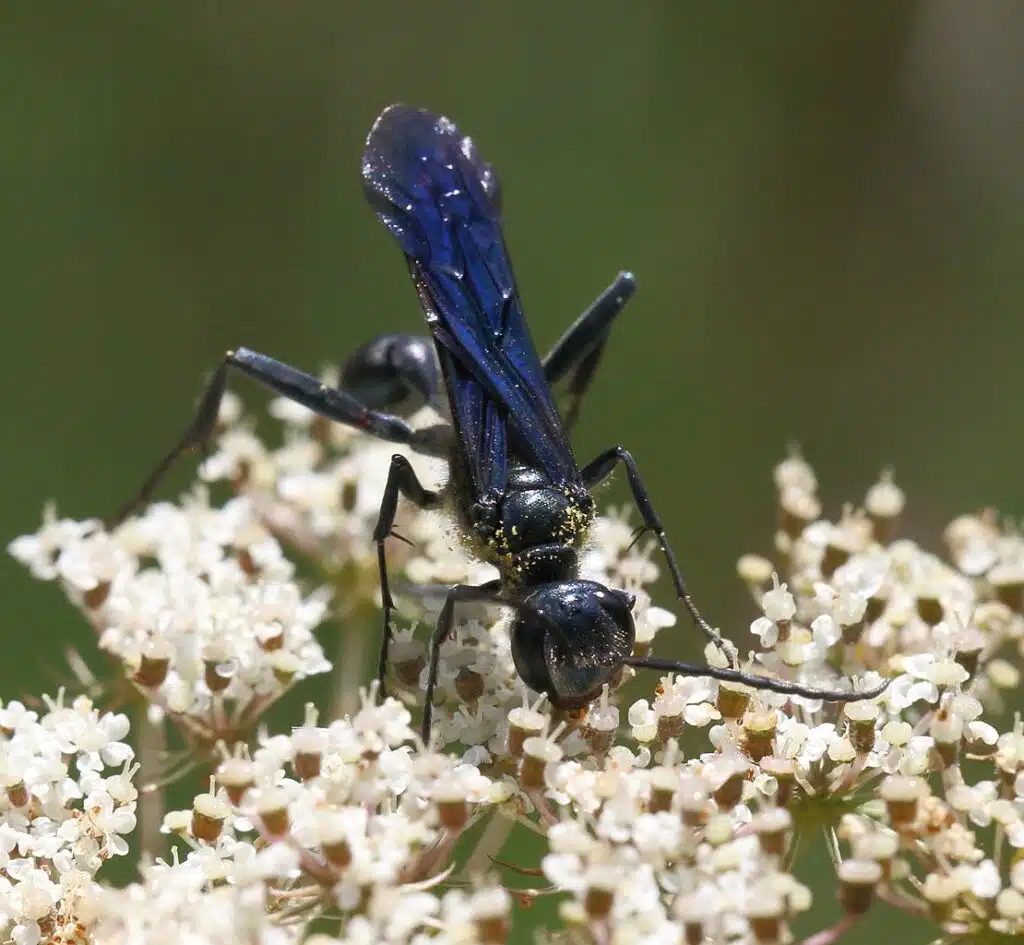
This species (Chalybion zimmermanni) is a common thread-wasted specie in North America. It has dark blue to black coloring.
A dark blue color is specific to its body, legs, and head.
Its color is glossy and it may appear silver-like in direct sunlight.
The Zimmerman’s Mud-dauber wasps is a parasitoid species. It lives in the nests of other wasps and it feeds on their eggs which it may also kill.
This species uses various bugs and insects as food for its larvae.
Female Zimmerman’s Mud-dauber wasps are mostly responsible for provisioning for larvae.
It’s also the females that build and maintain nests whenever they don’t invade other nests. Males have a purely reproductive role.
9. Oriental Mud-dauber Wasp
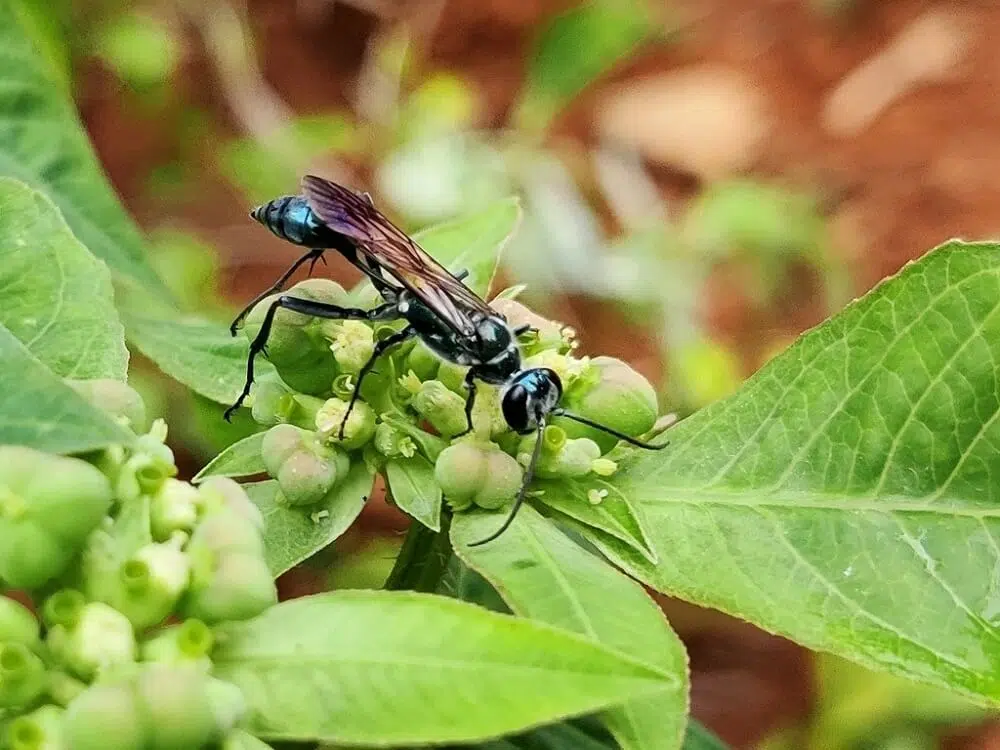
The Oriental Mud-dauber wasp (Chalybion bengalense) is a species of blue-green wasps. It has large black eyes and large black wings.
Wasps of this genus also have short white hairs on the abdomen.
This species is known for repurposing existing holes or cavities as nests.
Oriental Mud-dauber wasps might also create small mud nests in the absence of a suitable nest.
Female Oriental Mud-dauber wasps are also known for hunting spiders that feed their larvae.
10. Milde’s Tarantula-hawk Wasp
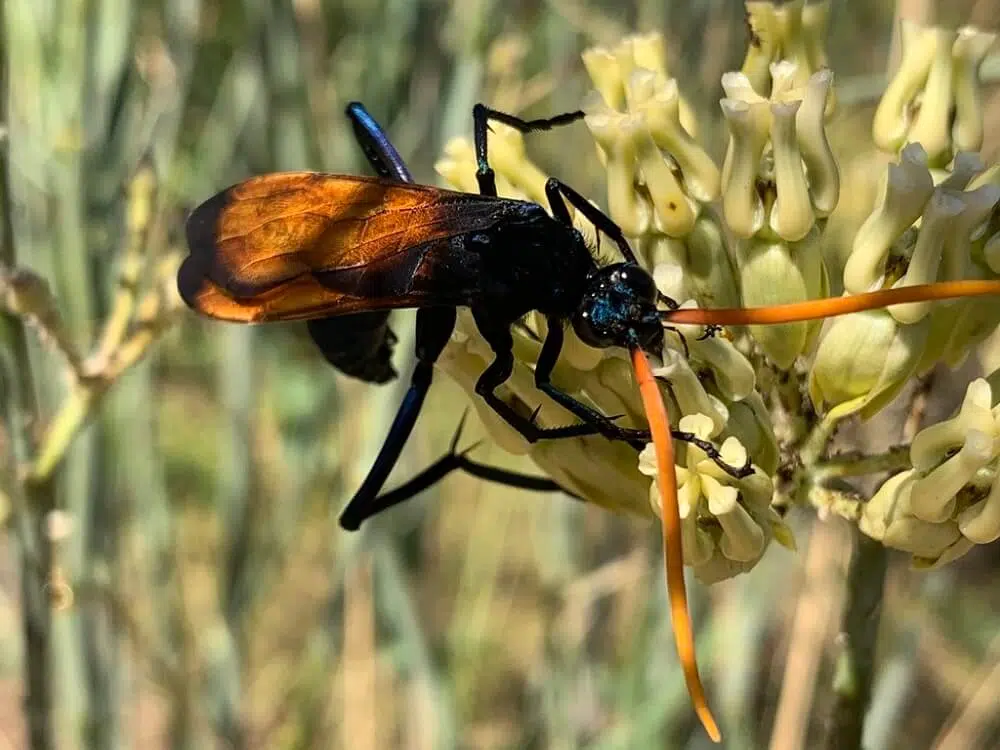
These types of wasps (Pepsis mildei) are known to be very dangerous to humans. Their sting is considered highly painful.
The Milde’s Tarantula-hawk wasp specializes in capturing tarantulas.
A long stinger and a large body help it paralyze tarantulas and carry them to the nest.
Milde’s tarantula-hawk wasps are known for only paralyzing tarantulas. They use their stinger on the lower part of a tarantula’s body, which is softer and easier to sting.
The females then drag a large tarantula back to a nest where they lay an egg on top.
One of the particularities of the venom Milde’s Tarantula-hawk wasp produces is its capacity to paralyze but not sting tarantulas.
This is why the tarantula doesn’t die and decompose as larvae grow.
Tarantulas captured and fed to the larvae of the Milde’s Tarantula-hawk wasp remain alive up to the last instar of the larvae.
11. Aporus hirsutus
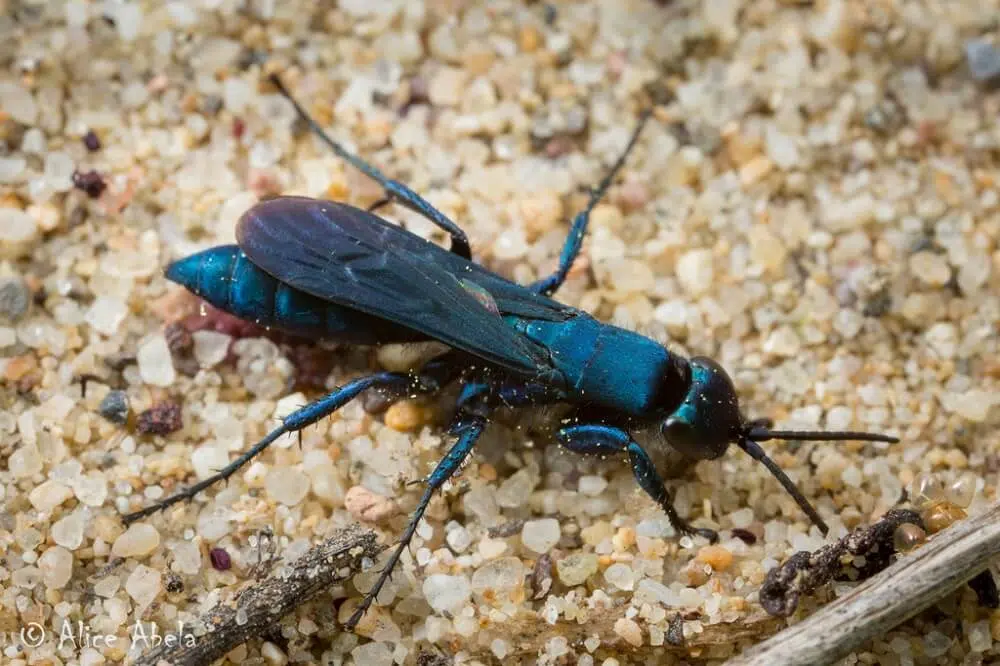
This species is known for its dark blue color. It almost appears black.
Its shiny body makes it stand out even as it’s a mostly dark color wasp.
The Aporus hirsutus feeds on nectar but its larvae feed on insects.
The species is native and exclusive to California.
You can find it in areas around San Jose and Los Angeles.
This species is a different wasp which means it builds individual nests in the ground. Wasps of this species are only found in sandy areas on California beaches.
12. Thisbe’s Tarantula-hawk Wasp
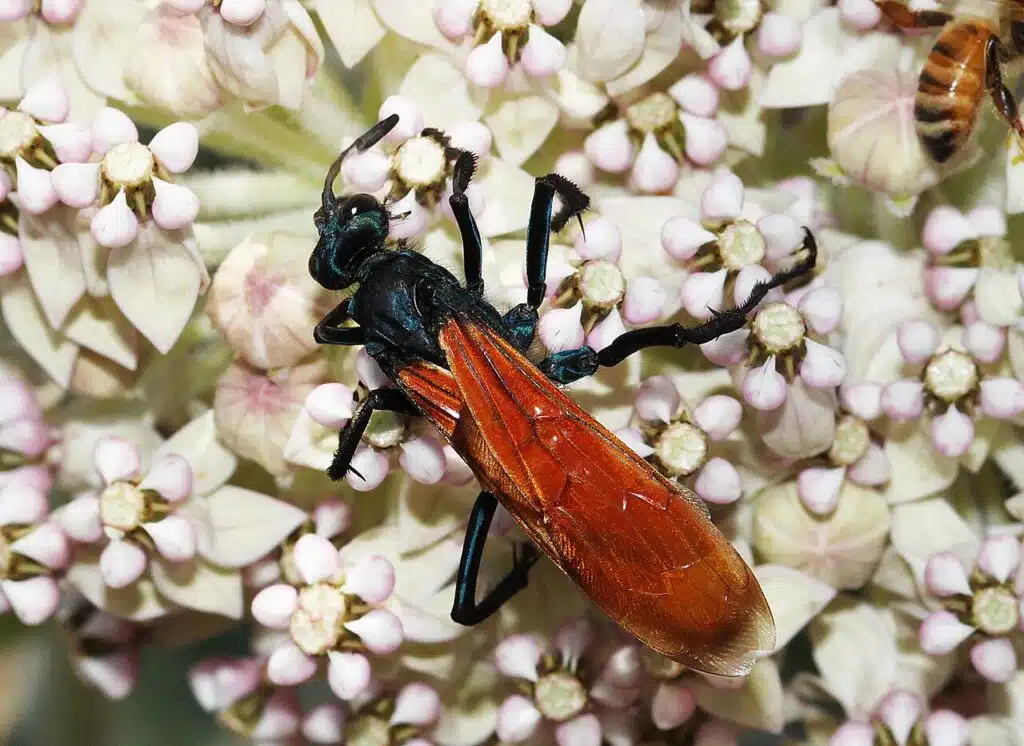
This type of wasps (Pepsis thisbe) is known for its very painful sting. Wasp of this family is native to the area of The Grand Canyon.
Females of the species are known to be highly dangerous to people as they can sting using very long stingers.
Female Thsibe’s Tarantula-hawk wasps have 7mm stingers.
These wasps have a dark blue body with black sections and orange wings.
Both males and females are seen on various flowers as they exclusively feed on nectar.
Thisbe’s Tarantala-hawk wasp’s transition from eating spiders to eating nectar into adulthood.
The larvae of the species are known for eating tarantulas fed by the female Thisbe’s Tarantula-hawk wasp.
While the species isn’t known to be particularly aggressive against humans it’s still best to stay back as they have a potent stinger.
Males cannot sting but females have one of the most painful stings in the world of insects.
13. Elegant Tarantula-hawk Wasp
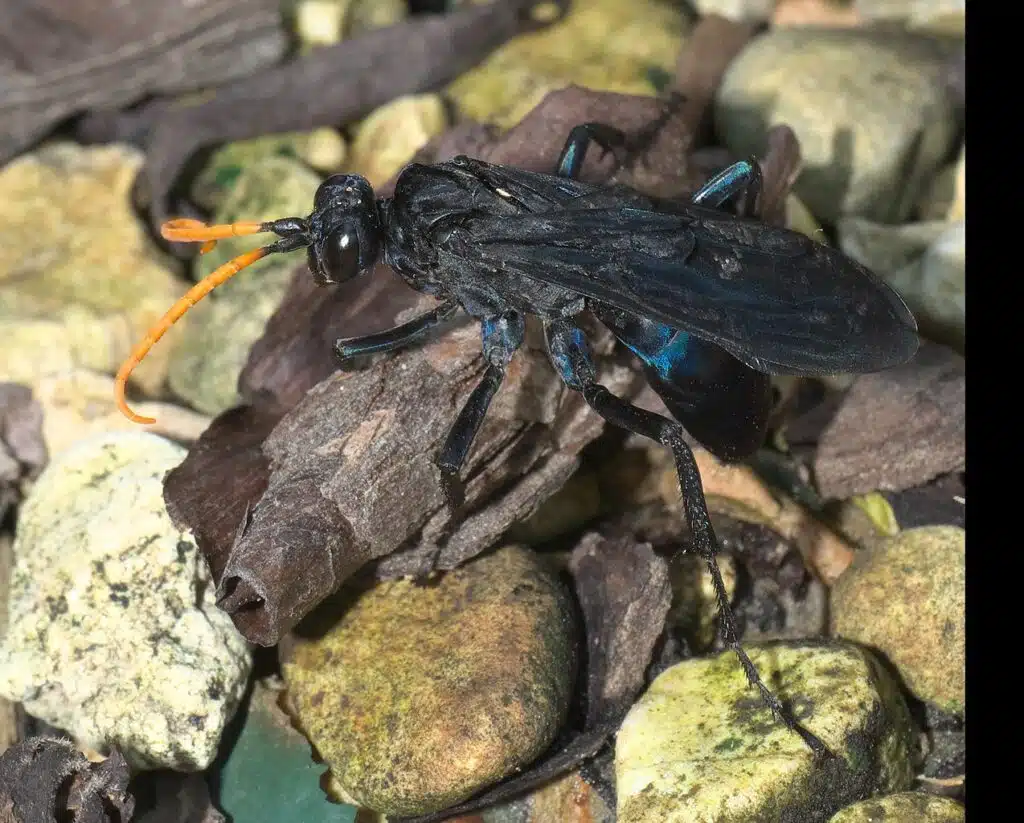
The Elegant Tarantula-hawk wasp (Pepsis menechma) has a dark blue body and black wings.
This is a mid-sized wasp by North American standards when it comes to blue and black coloring.
Wasps of this species are particularly known for eating nectar and feeding a wide range of spiders to their young.
Almost any type of large spider can be a meal for the larvae of the species.
Unlike other wasps that only feed tarantulas to their larvae, the female Elegant Tarantula-hawk wasps also feed other types of large spiders to their young.
14. Blue Flower Wasp
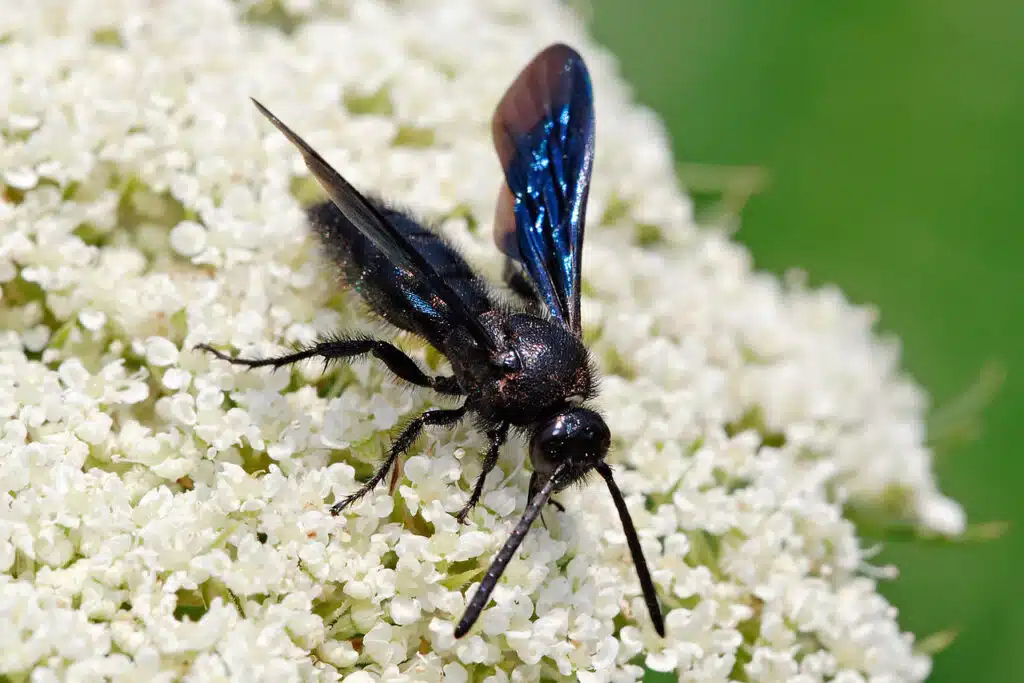
The Blue Flower wasps (Austroscolia soror) is a species of blue and black wasps from Australia.
Its size is small compared to other parasitic wasps as it mainly grows to 1.5 inches.
Wasps of this genus are known to feed on nectar. Young wasps of the species are fed larval beetles.
It’s the female Blue Flower wasps that seek out the eggs or larvae of various beetles. It uses them as nests and food for its larvae.
15. Ruby-tailed Cuckoo Wasp
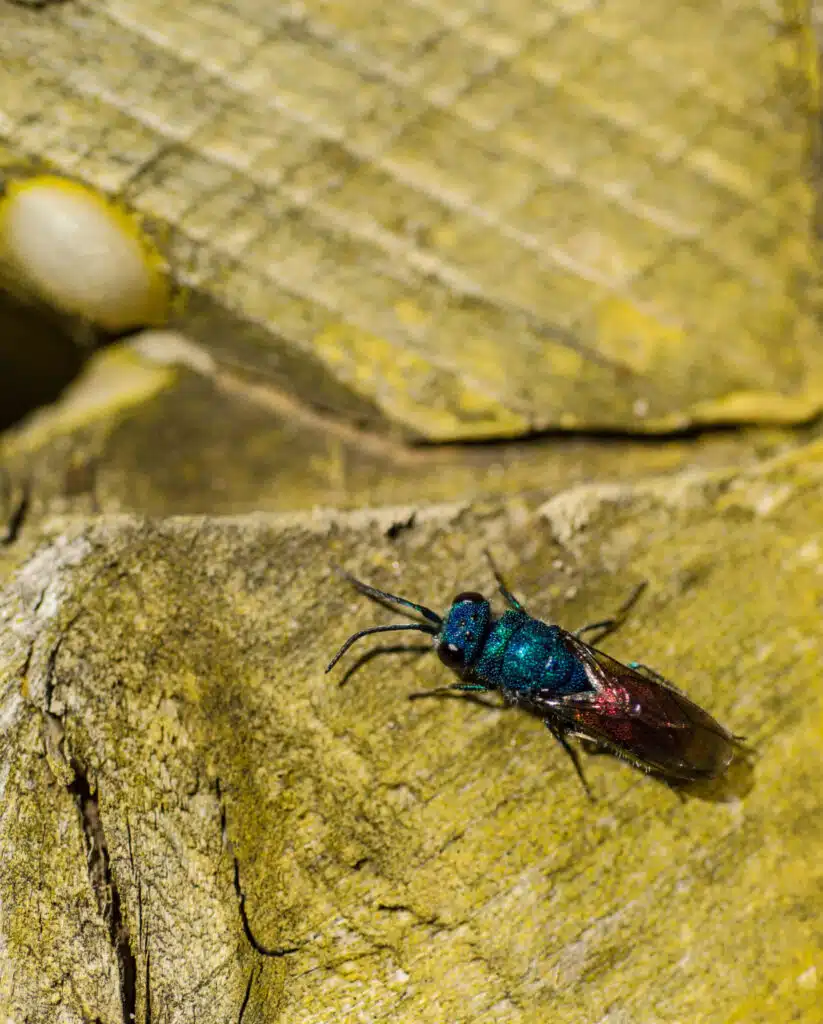
These blue, black, and orange wasps (Chrysis ignita) are known not to sting. They don’t have stingers but they are still a parasitoid species.
Ruby-railed Cuckoow wasps can be parasites of many species of insects. They prefer to be a parasite of mason bees as these are easier to kill.
Female Ruby-tailed Cuckoo wasps are known for laying eggs in the nest of mason bees.
Creativity is needed for females to make it inside the nest of various bees where they become a parasite.
Since they cannot sting, females can produce a mimicking odor. They produce a type of chemical which resembles the odor of the host bee species.
This allows the female Ruby-tailed Cuckoo wasps to infiltrate nests.
They lay eggs that eat the eggs of the host bee when they become larvae. This process largely goes undetected, mainly due to these wasps employing odor-mimicking techniques.